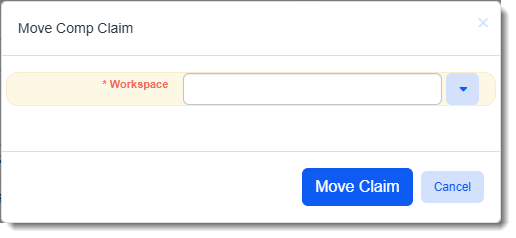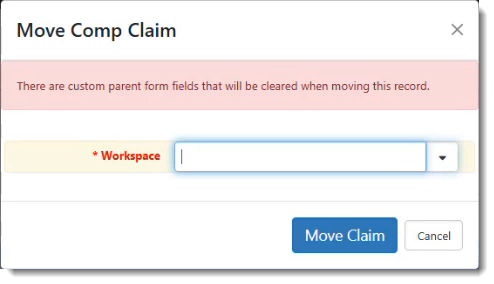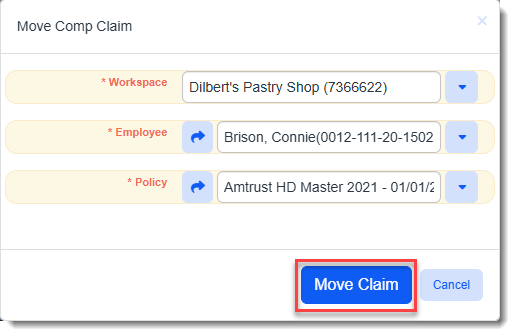Administering a Workers' Comp Claim
The Workers' Comp claim form comprises multiple tabs: Home, Comp Claim Claimant, Comp Claim Injury, and Comp Claim Legal.
You can:
- administer Workers' Comp claims
- provide details of the injury
- delete a claim
To administer Workers' Comp claims:
- In the modules bar, select WC Claims.
A list of WC Claims displays. From here you can Add, Edit, Delete, and Move Claim. - To edit an existing claim, locate the entry and click
 (Jump).
(Jump).
See the following table to complete the form fields. - To add a claim, click Add.
The Workspace Selector page opens. - In Choose a Workspace, select an entry from the list, and click GO.
The Comp Claim form opens. - Complete the form:
Note: Most of these fields can be hidden, added or repositioned upon request. However, this may occur billable time. If you have an Advanced Admin license, you can make the changes on your own.
|
Claim Details |
This section is dedicated to details about the worker's comp claim located on the Home tab. |
|
Employee |
Select the Employee who is making the claim. This is a parent field directing back to the Employees in a Client workspace. (Hint: Use the wildcard percent character (%) to search by employee's first name, last name or ID.) |
|
Date of Injury |
Select the date of injury. (Hint: Use t,d,w,y shortcuts to quickly enter in the date.) |
|
Jurisdiction State |
Select the state that has jurisdiction of the claim. Note: This uses the US States lookup group. |
|
Claim Status |
Select a status. Options are: Open, Closed, Denied, Re-Open, and Pending. |
|
Policy |
Select your WC Policy (i.e., Workers' Comp policy in ClientSpace.) It is formatted to display the Policy Title - Policy Effective Date. Selecting the Policy also enables the Carrier Claim Adjuster field. |
|
Claim Type |
Select the claim type: Indemnity, Medical Only, Report Only.
|
|
Carrier Claim Number |
This is the claim number given by the carrier. This may not be applicable for Report Only claims. |
|
ClientSpace Claim ID |
Auto-filled with the claim Primary Key Identifier (PKID). |
|
Carrier Claim Type |
A way to categorize the claim provided by the carrier. This field is typically auto-filled by Loss Run imports. |
|
OSHA Case Number |
The OSHA Case Number is read-only and is set using auto-numbering business logic on insert of the claim form. This numbering begins at 1 at the beginning of each calendar year based on the Date of Injury (DOI) year of the claim within the Workspace. The rule is configured to run on the Default and Imports pipelines. If the Injury Date of a claim changes, a warning is triggered to notify the user that the OSHA Case Number will be re-generated. The case is then auto-numbered based on the new Injury Date. The Case Number is set based on the next available case number for that year. The OSHA 300 report and OSHA 301 Merge (run from Comp Claim) show the Case Number and is sorted by lowest to highest. The Case Number is shown if present, otherwise, it will show the Carrier Claim Number. |
|
Time of Injury |
Enter the time the injury actually occurred. |
|
Start of work (DOI) |
This is the time the employee started their work day on the day they were injured. |
|
Employee Report Date Employee Report Time |
Enter the date and time of the report. |
|
Client Report Date |
Client Report Date defaults to the current date. This is the date the client reported the claim to the carrier. |
|
Carrier Report Date |
This field is "read-only" and is typically filled in during a loss run import by the carrier. It is the date they received information regarding this claim. |
|
Claim Specialist |
This defaults to the user creating a claim, but you can reselect it from the drop down list if needed. |
|
Carrier Claim Adjuster |
This field is "read-only" until a WC Policy is selected in the Policy field. Once a WC Policy is selected, the list of adjusters is filtered to the contacts provided on the policy's organization and you can then select an adjuster. |
|
TPA |
TPA stands for Third-Party Administrator. Usually clients who need to submit information via API use this method. (For email, we recommend using email templates.) |
|
Transmission Status |
This field works in conjunction with the TPA field to send the claim information to the Third-Party Administrator. Select a status: Hold, Ready for Transmit, Transmitted. Note: You can hide this field if you do not use a Third-Party Administrator. |
|
Claim Deductible |
ClientSpace retrieves the deductible from the Pricing Batch first (if it exists) and uses it to set the Claim Deductible. Note that the Current Record checkbox must be checked on the Pricing Batch, denoting it as the current Pricing Batch. Also note that if the deductible is set to $0.00 on the current Pricing Batch, it is treated as a valid value and may be used in deductible bill amount calculations. If there is no current Pricing Batch record, ClientSpace sets the Claim Deductible using the WC Deductible field from the Client Master record. This field can then be used in unison with the Claim Financials to create claim deductible bills. We can also then directly create bill pending items in Prism with this information. |
|
Similar Employee |
This field is used to select another employee with similar wages to use for indemnity or out of work benefit determinations. |
|
Communications Log |
Used for any notes or correspondence associated with the Claim |
|
Show Details |
Select this option to display the Additional Claim Information section. |
|
Employee Vouchers Retrieved |
This shows whether vouchers are now available to view in ClientSpace for this employee. This is primarily used to work with Wage Statements. |
|
Additional Claim Information |
This section is dedicated to additional claim information about the worker's comp claim. |
|
Close Date |
Date the claim is closed. This field is set automatically, when the status of the claim equals Closed. This field clears if claim states does not equal Closed. |
|
Resulted in Death |
Indicate whether the claim resulted in death. |
|
Date of Death |
If the Resulted in Death field contains Yes, indicate the date of death. |
|
Claim Reported By |
This is a text field that allows you to enter the name of the person who reported the claim. |
|
Shock Loss |
This is used to denote and unexpectedly high dollar amount claim. |
|
Suppress on OSHA Log |
Indicates if the claim is included or excluded from the OSHA 300A report.
|
|
Privacy Consideration |
When selected, the Claimant's Name on the OSHA 300 report is replaced with the word Private. |
|
FMLA Event |
Indicate whether the claim is related to FMLA (Family Medical Leave Act).
Note: If you use the Leave of Absence module, you can track the leave time as well. See Leave of Absence Tracking. |
|
3 Lost Work Days? |
Indicate whether the claim resulted in more than three lost work days. |
|
Drug Screen Completed |
Indicate whether a drug screening was completed. |
|
Results |
Indicate whether the result of the drug screening was positive or negative. |
|
Details |
Indicate any details regarding the drug screening results. |
|
Employee's Normal Job |
Indicate whether , at the time of the incident for the claim, was the employee performing their normal job duties. |
|
Employee Safety Violation |
Indicate whether the individual violated safety standards when the injury occurred. |
|
Light Duty Available |
Indicate whether the individual can perform other alternative light-duty work that would not affect the injury. |
|
Employee Driving |
Indicate whether incident occurred while employee was driving. |
|
Vehicle Type |
If the Employee Driving field contains Yes, indicate the type of vehicle that the employee operated during the incident. |
|
Ticket Issued |
Indicate whether the police or other agency issued a ticket as the result of the incident. |
|
Fraud Suspected |
Select this check box to indicate that fraud is suspected for this incident. |
|
Litigated |
Select one of the following options to indicate the litigation status:
|
|
Eligible for Subrogation |
Select this options to indicate the subrogation status, which is defined as the right of an insurer to pursue the party that caused the loss to recover funds paid in the claim. |
|
LDF |
ClientSpace uses business rules to set the Loss Development Factor in the LDF field using the LDF data set up in the Admin Workspace. See Adding and Maintaining Loss Development Factors. |
|
Best Hazard Index |
Enter a ranking of 1 - 10 to denote how hazardous the employee's job is (with 1 being the least hazardous and 10 being the most hazardous.) |
|
Best Hazard Class |
Enter the Best Hazard Class associated with this company |
|
Financial Notes |
Any information regarding the financial aspects of the claimant or the company. |
|
Additional Details |
Any additional information regarding the claim. |
|
Audit |
An ongoing record of changes to the claim and who made the changes. The following fields are audited:
|
|
Is the claim COVID-19 related? |
Select this option to indicate whether this claim is to an employee who became ill with COVID-19 while performing work-related activities. |
- Click Apply.
To provide details of the injury:
- Click the Comp Claim Injury tab.
- Complete the fields.
|
Privacy Consideration |
When selected, the Claimant's Name on the OSHA 300 report is replaced with the word Private. |
- Click Save.
To move a workers' comp claim:
-
In the modules bar, select WC Claims.
A list of WC Claims displays. -
Click the row of the claim you want to move in the grid and then click the Move Claim button at the top right corner of the grid.
The Move Comp Claim window displays.
Note: The Move Comp Claim window displays the following message if there are any custom parent form fields on the Comp Claim dataform to indicate these fields will be cleared:
The message above will be shown if there custom parent form fields in any of the following locations:
-
The Home Comp Claim dataform.
-
The standard tabbed forms on the Comp Claim: Comp Claim Claimant, Comp Claim Injury, and Comp Claim Legal.
-
Any other custom tabbed forms that may be attached to the Comp Claim dataform.
-
-
Select the Workspace where you want to move the claim.
-
Select the name of the Employee in the workspace.
-
Select the Policy.
-
Click Move Claim at the bottom of the Move Comp Claim window.
When the action is complete, a "Comp Claim moved to new workspace" message briefly displays at the top of the Move Comp Claim window and the window closes.
To send an FROI:
On new claims, if there is an FROI email template set up, you can send a First Report of Injury (FROI) notification email to an insurance carrier, a client, or an internal team member notifying them of a new Worker's Compensation claim.
-
Click Send FROI under Workflow in the Action Center of the Comp Claim.
To delete Workers' Comp claims:
- In the modules bar, select WC Claims.
A list of WC Claims displays. From here you can Delete a claim. - Use the Quick Search bar to find a claim to delete.
See Quick Search. - Select the row that contains the claim to delete and click Delete.
The system displays a message about deleting the claim.
|
If the system displays the following message: |
Then complete the following: |
|---|---|
|
Are you certain you want to delete this Claim and related forms? |
Click OK to confirm the deletion of the claim. |
|
This Claim has active Notes and or Attachments, and cannot be deleted |
You cannot delete a claim that has active notes or attachments. You must administer the claim and remove any active notes or attachments before you can delete the claim. Click OK and correct the issue before trying again. After correcting the issue, repeat this procedure to delete the claim. |



